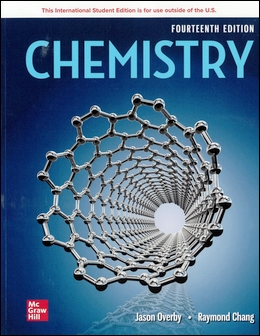書籍分類

Chemistry 14/e (絕)
作者:Raymond Chang, Jason Overby
原價:洽詢
內容介紹 本書特色 目錄 作者介紹
- Description
Chemistry, 14th Edition, continues a long-standing tradition of providing a firm foundation in the concepts of chemical principles while instilling an appreciation for the important role chemistry plays in our daily lives. This text provides a balance of theory and application, while illustrating the principles with applicable examples.
分類位置:
無
- Content Changes
-
Chapter 1
- This chapter has been reorganized to better accommodate the study of measurements versus the study of matter in a more logical presentation.
- Updated definitions of the fundamental SI units are now given based on the revisions in 2019.
- The significant digit rules for logarithmic values are now discussed.
- Information on systematic and random errors has been added in conjunction with accuracy and precision.
- A more detailed discussion of the phases of matter is provided to further dispel the misconception that there are only four or five phases of matter.
- Chapter 2 This edition of the text now exclusively uses the IUPAC designation of 1-18 for groups on the periodic table.
- Chapter 3 A new discussion of the concept of atom economy has been added. This important idea in green chemistry adds a counter point-of-view to percent yield while adding an environmental focus in synthetic chemistry.
- Chapter 4 We have now combined the two separate sections on acid-base and redox titrations to illustrate that titrations are simply a technique regardless of the type of chemical reaction occurring.
- Chapter 5 New information about the bar pressure unit has been included.
- Chapter 6 The description of energy to open the chapter has been reorganized for a more logical presentation. We now use c for specific heat capacity as noted by the IUAPC Gold Book instead of s.
-
Chapter 7 New information about the foundation-building double-slit experiment, as well as interference of waves, is now provided.
- The discussion of the photoelectric effect has been New insight into the importance of the Planck constant is provided.
- New material on the importance of the Heisenberg uncertainty principle is given.
- The idea of spin correlation has been introduced.
- The correct IUPAC nomenclature lanthanoids and actinoids are now used.
- Chapter 8 The inert pair effect is now introduced.
- Chapter 9 The discussion of lattice enthalpy has been rearranged as well as expanded. Additionally, the discussion of electronegativity has been updated and reorganized.
- Chapter 10 The discussion of orbital hybridization has been updated for a more logical flow. And a disclaimer has now been added to the discussion on the controversial topic of d-orbital hybridization.
- Chapter 11 New material on intermolecular forces has been added along with a new table illustrating the relative strengths of the various types of intermolecular forces. Also, the discussion of phase diagrams has been updated with a more thorough introduction.
-
Chapter 13
- New material on units in rate laws has been added.
- Updated material on the temperature dependence of reactions is included.
- The discussion of reaction mechanisms has been reorganized.
- New insights on catalytic activity and enzymes are provided.
- Chapter 16 The discussion of factors affecting solubility has been completely reorganized for a more logical flow of material.Chapter 17 The entire discussion of entropy has been reorganized and updated to better reflect our current understanding of entropy as the dispersal of energy. Numerous new figures to help illustrate this concept are now provided. Further, we now exclusively use Gibbs energy given its IUPAC designation for the thermodynamic quantity △G.
-
Chapter 19
- Extensive rewriting and updating of the material on radioactive particles and balancing nuclear reactions has been done.
- There is now a small discussion of the strong nuclear force in relation to the idea of nuclear stability.
- An expanded discussion on radioactive processes relative to the belt of stability has been added.
- New information has been added on particle accelerators.
- Chapter 21 The entire section of the chemistry of iron and copper has been moved from Chapter 23 to Chapter 21 to better fit in the discussion of metallurgy.
- Chapter 23 The discussion of coordination chemistry geometry has been updated.
The following are just a few of the highlights of the fourteenth edition content revision.
- Table of Contents
1 Measurement and the Properties of Matter
2 Atoms, Ions, and Molecules
3 Mass Relationships in Chemical Reactions
4 Reactions in Aqueous Solutions
5 Gases
6 Thermochemistry
7 Quantum Theory and the Electronic Structure of Atoms
8 Periodic Relationships Among the Elements
9 Chemical and Bonding
10 Structure and Bonding Theories
11 Intermolecular Forces and Liquids and Solids
12 Physical Properties of Solutions
13 Chemical Kinetics
14 Chemical Equilibrium
15 Acids and Bases
16 Acid-Base Equilibria and Solubility Equilibria
17 Entropy, Gibbs Energy, and Equilibrium
18 Electrochemistry
19 Nuclear Chemistry
20 Chemistry in the Atmosphere
21 Metallurgy and the Chemistry of Metals
22 Nonmetallic Elements and Their Compounds
23 Coordination CChemistry
24 Organic Chemistry
25 Synthetic and Natural Organic Polymers
- Jason Overby
Jason Overby received his B.S. in chemistry and political science from the University of Tennessee at Martin, his Ph.D. in inorganic chemistry from Vanderbilt University, and conducted postdoctoral research at Dartmouth College. Since joining the Department of Chemistry and Biochemistry at the College of Charleston, Jason has taught courses from general chemistry to advanced inorganic chemistry, and conducts research with undergraduates. He is interested in integrating technology into the classroom, with a particular focus on adaptive learning.
Raymond Chang
Raymond Chang received his B.Sc in chemistry from London University, and his Ph.D. in chemistry from Yale University. After doing postdoctoral research at Washington University and teaching for a year at Hunter College, he joined the Chemistry Department of Williams College. He wrote books on physical chemistry, industrial chemistry, and physical science.


